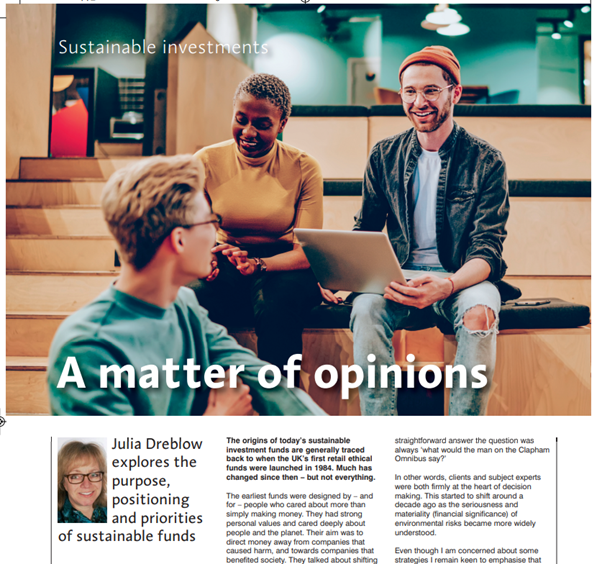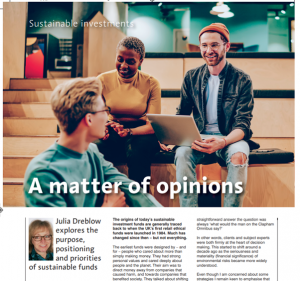Some thoughts on the Purpose, Positioning and Priorities of sustainable investment
Posted on: March 18th, 2022

A big thank you to our friends at Investment Life and Pensions Moneyfacts for publishing – and putting on the front cover – my latest piece on sustainable investment.
You can download a pdf of the text here:
The text – as submitted – is below.
Sent to Investment Life and Pensions Moneyfacts 21 Feb 2022
‘Exploring the purpose, positioning and priorities of sustainable funds’
The origins of today’s sustainable investment funds are generally traced back to when the UK’s first retail ethical funds were launched in 1984. Much has changed since then – but not everything.
The earliest funds were designed by – and for – people who cared about more than simply making money. They had strong personal values and cared deeply about people and the planet. Their aim was to direct money away from companies that caused harm, and towards companies that benefitted society. They talked about shifting capital markets, with wry smiles – and occasionally worked to encourage progress – albeit initially ad hoc.
Most funds launched before the 2008 financial crisis followed a similar pattern. They employed people who understood and cared about environmental, social and ethical issues – either in or alongside the fund management function. Many employed external advisory committees, to widen their knowledge base and add rigour.
There were occasionally fraught exchanges between clients and managers, often when profitability and ethics clashed. I still bear the bruises from the exchanges about the Daily Mail, Provident Financial and Tesco – and still prefer not to talk about animal testing as it is such a difficult area. Most disagreements were resolved pretty amicably though – and when there was no straight forward answer the question was always ‘what would the man on the Clapham Omnibus say?’
In other words, clients and subject experts were both firmly at the heart of decision making.
This started to shift around a decade ago as the seriousness and materiality (financial significance) of environmental risks became more widely understood.
Even though I am concerned about some strategies I remain keen to emphasise that the challenges we face demand mass collaboration, so their involvement is welcome.
However, the shift away from expert opinion and contact with real clients has come at a cost. Too many funds are failing to explain what they are for, why they exist and what they do – and so risk misleading clients.
These are the issues that underpin the current regulatory activity that is currently underway.
Part of the problem has been the engagement vs divestment debate. Some managers say it is wrong to have exclusions or divest, as asset managers should encourage progress through engagement. However most will concede that if engagement fails they will eventually divest.
Most sustainable funds purport to hold companies that can contribute to a more sustainable future. However, views vary on what that means. Some focus on (all too few) companies solving problems, displaying high standards – or in some way leading the necessary transition. Some focus on ‘broadly uncontroversial’ companies. These are variations on what most clients probably expect when they see the word ‘sustainable’. Others invest very widely, focusing more on engagement with, for example, oil companies.
This variation is proving problematic, not because it is wrong per se, but because it confuses clients. So here are some thoughts on how we might tidy this up:
Focus on real issues – and collaborate.
Given that the planet’s resources are finite and that clients have good reason to be concerned, fund managers should have a far clearer focus on real issues – not industry constructs like indices, ratings and benchmarks, which may be gamed by clever companies. They must also collaborate more – and explain this activity better to clients.
A recent article in the New Scientist illustrates the magnitude of one of the many issues we face – waste.
Citing the work of the Ellen MacArthur foundation and Circle Economy a recent piece in the New Scientist, talked about our collective use of ‘stuff’: ‘To fulfil our materials wants, humanity now uses some 100 billion tonnes of stuff every year. More than 90 per cent of it is virgin material that is mined, drilled or hacked from the planet’s surface. Only 30 billion tonnes of it makes anything of permanence [such as buildings]. The rest is burned as fuel or used fleetingly and discarded – at each stage polluting land, water and air and increasing climate-changing greenhouse emissions’. The article goes on to say that only 8.5 percent of this waste is recycled – and that this is getting worse not better.
No community – informal or otherwise – is better placed to help sort this out than investors.
By really understanding problems and investing in companies that are solving them asset managers can benefit themselves, their clients and wider society. But no investment organisation can do this alone. System wide change requires system wide solutions. Communicating with clients and working with competitors are both part of the solution.
Collaborative investor groups such as Climate Action 100+ and IIGCC have shown that working together and directly targeting problem companies can work.
Tweaked indices may help but are – at best- unproven agents of change.
Being humble
Being trusted to manage people’s savings is a big responsibility and we need managers to be confident – but when it comes to environmental and social issues being humble is a strength.
Although data is improving it is often imperfect, incomplete or irrelevant when scrutinised. Most research data is also retrospective, which is a problem as the future will be very different. Forward looking climate metrics like implied temperature rise projections are a notable useful development. But realistically – none of us can see into the future.
Consumers, policy makers and market responses are notably unpredictable. This was highlighted in a brief presentation I enjoyed recently – given by Mark Cliffe (of KPMG, LIBF). His economist’s mind led him to map climate scenarios onto a 2 x 2 matrix, where ‘Policy intervention’ (ie government responses) is mapped against ‘Market Dynamism’ (how investors and others react to climate risk).
His best outcome was nicely labelled ‘the Roaring 20’s’. This is the scenario where government policies and market mechanisms work together to achieve net zero greenhouse gas emissions. The worst was labelled ‘Meltdown’ – where both markets and politicians fail to act.
Both outcomes are plausible – as are many scenarios in between.
However, what we are reasonably confident about is that change is possible. If the finance community collaborates and forces polluters to wind down polluting activities (by both withholding capital and voting out directors when needed) – and scales up green solutions with massive investments – a transition is entirely possible. Mark refers to this scenario as a ‘Green Phoenix’.
He’s been in this area a long while, as have I. All I’d add is that if someone suggests a simple solution to the many interconnected challenges we face – you might like to consider their motives.
Better communication
This area now has its own rich vocabulary. Most professions do. Unfortunately, for historic reasons, retail and institutional markets have evolved differently and use different terms, but that’s a different matter.
One of the most important terms, or concepts, that is not talked about often enough is ‘intentionality’ – or ‘what a fund is for’, its ‘purpose’. Making money is a given. All funds should do that. What makes good sustainable (and related) funds different is that they are trying to do more. Their aims and methods vary – but in essence they all have one or more environmental and or social topic that they care about.
This makes, or should make, sustainable options very different from funds that simply say they ‘consider ESG’ – which could mean a manager considers it for only a nanosecond.
So, when explaining funds to clients managers need to explain what they do and why. ‘How’ they operate is important also, but methodology should play second fiddle to purpose, in my view.
When describing strategies managers must also strike a careful balance between enthusiasm and realism.
Overstating the importance of a small shareholding in a large company is inappropriate. But likewise, history tells us that if we underplay the relevance of favouring more sustainable companies, we get a behaviour agnostic investment market that undermines its own, and our futures. So, (carefully explained) credit where credit is due.
Moving forward
Policy makers and regulators recognise investors have a role to play in addressing climate change – and that sustainability matters. Most of us would also agree that the purpose of investment is to enhance wealth, not destroy it.
These should make sustainability and investment natural partners, but time is tight – and there are many vested interests. Addressing sustainability challenges represents both the biggest threat and the biggest opportunity of our time.
Variations in fund strategy are definitely not the problem – this can help guard against bubbles and effect change – and diversity of opinion is the lifeblood of financial markets. However, making sure clients are properly matched to funds is an issue.
Thanks to increased awareness, most people outside of our industry are likely to expect sustainable funds (and their managers) to be both pushing companies to improve and avoiding fossil fuel companies within sustainable portfolios.
The information we hold on Fund EcoMarket illustrates the challenge intermediaries face.
Of the 578 OEICs, SICAVs, ETFs and Investment Trusts currently listed 175 tell us they ‘Aim to deliver positive impacts’. 141 of these are run by companies which are members of engagement groups ‘IIGCC or Climate Action 100+’, however this drops to 126 funds when building in ‘Exclude coal, oil and gas majors’ also. So this is not easy.
Not every fund manager gives us detailed information, so the precise number might be a little higher, but it shows intermediaries cannot assume funds are all the same. Different strategies suit different clients – and clients should know what they are getting.
The sustainability disclosures (SDR) and labelling work the FCA is carrying out, relates to such things. And, naturally, opinions on the advisory group also vary.
No decision has yet been made about new requirements. We are expecting a consultation paper mid-year. But in the meantime, I’d suggest getting back to basics, gathering – perhaps even humbly – both expert and interested clients’ opinions. They will serve you well. Finding a Clapham Omnibus may prove harder!
Julia Dreblow, Director SRI Services, Founder Fund EcoMarket
SRI Services runs the free to use Fund EcoMarket database and sits on the FCA Disclosures and Labels Advisory Group (DLAG).
